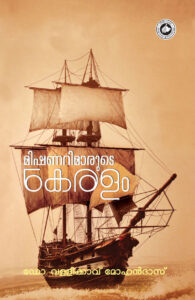
Dr. Vallikkavu Mohandas
Kerala Bhasha Institute, Thiruvananthapuram, 2023.
Reviewed by: Dr. Vysakh Remesan (PhD, Indian Institute of Technology, HYI Visiting Fellow)
This book is a deep dive into the role of European Christian Missionaries in the socio-cultural and political history of Kerala, the southernmost state of the Indian subcontinent. Across twelve chapters, the author presents a detailed account of the missionaries’ diverse contributions, ranging from the introduction of print technology and newspapers to advances in education, social reform, and literary production. The first two chapters on print technology deal with the history of print culture in Kerala, which started in the late 16th century. The technology was introduced to the region by Portuguese missionaries, and the first book produced in Malayalam language was a translated Christian doctrine, intended for proselytization. Production of printed materials in this initial phase was sporadic, and it took a few more centuries for printing technology to properly take root in the region. This period also saw early European engagements with Malayalam, including Johann Ernst Hanxleden’s early 18th-century grammar.
The two chapters that follow discuss the history of newspapers in Malayalam, specifically focusing on Rajyasamacharam and Paschimodayam, the first newspapers in Malayalam that began publication in 1847. These newspapers were published by the Basel Christian Mission in northern Kerala under the leadership Rev. Herman Gundert. Rev. Gundert was a pioneering figure in the history of Malayalam language, credited with producing a comprehensive Malayalam-English dictionary as well as standardizing the language and its script through production and circulation of printed material. The author discusses in detail the way in which, in spite of being missionary publications, these two newspapers widened the social as well as scientific horizons of its readers by publishing articles about developments from around the world. He claims that the cultural shifts set in motion by these developments played a significant role in the social reform movements of later centuries.
This perspective is further developed in the next chapter, which discusses the efforts of missionary societies to bring literacy to the masses through the establishment of educational institutions. Although these efforts were ultimately in service of the British colonial empire, the author shows that it benefited members of several marginalized communities as well. Communities that were denied the right to learn by the rigid and oppressive caste system were able to gain new forms of social capital by joining educational institutions started by missionaries. However, the contributions of missionaries were not limited to such passive effects. As the author shows in the subsequent chapters, they played an active role in social reform movements such as the Channar revolt, a movement aimed at securing the right for lower-caste women to wear upper-body garments. This ranged from sending petitions and memorandums to kings and British administrators to providing the upper-body garments for these women to wear. Furthermore, missionaries also advocated for conversion to Christianity as a way out of the oppressive Hindu caste regime and actively recruited the most oppressed into their fold with an aim of upliftment.
Finally, the author also touches upon the contributions made by missionaries to the literary genres of the region. Western genres, such as pastoral elegy, eclogue, stage plays etc. were introduced to the audiences of Kerala by the priests who produced Malayalam works in these genres. These productions paved the way for the emergence of a strong theatre culture in Kerala, which, in combination with the communist movement in the 20th century, played a crucial role in Kerala’s modernization.
The author has done an excellent job of bringing together historical evidence from a wide range of domains to provide an extensive account of how Christian missionaries and their actions shaped the socio-cultural evolution of Kerala. Having said that, the author could have paid more attention to the connection between the missionaries and the colonial apparatus. Although the aim of the book was to account for the contribution of the missionaries, providing the necessary context of colonial exploitation within which such contributory work was taking place would have strengthened the author’s analysis even further. Nevertheless, this book is an important resource for students of Kerala’s colonial and religious history.
